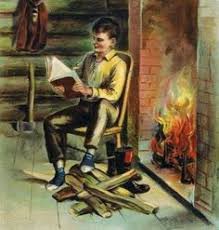 “Upon the subject of education,” Abraham Lincoln wrote in his Communication to the People of Sangamo County in 1832, “I can only say that I view it as the most important subject which we as a people can be engaged in.”
“Upon the subject of education,” Abraham Lincoln wrote in his Communication to the People of Sangamo County in 1832, “I can only say that I view it as the most important subject which we as a people can be engaged in.”
True to his word, on December 2, 1840, during his tenure in the Illinois state legislature, Lincoln offered a resolution: “That the committee on education…inquire into the expediency of providing by law for examination as to qualifications of persons offering themselves as school-teachers, that no teacher shall receive any part of the public school fund who shall not have successfully passed an examination.” This resolution is embodied in sec. 81 of common school code adopted at this session.
Up to that point, teachers on the frontier weren’t required to have any qualifications beyond “readin, writin, and cipherin’ to the Rule of Three.” The state of education on the frontier was so limited that “if a straggler supposed to understand Latin, happened to so-journ in the neighborhood, he was looked upon as a wizzard.” Even with his limited access to formal education, Lincoln quickly outclassed his occasional teachers in capability, mostly because he did what he could to “pick up from time to time under the pressure of necessity” any other education. To give him proper credit, that included teaching himself English grammar, Euclid geometry, surveying, and the law.
In fact, a closer look at Lincoln’s ciphering book (often referred to as his “sum book”) shows that Lincoln was less than forthcoming about his educational achievements, intentionally downplaying his expertise for political expediency. The ciphering book includes an additional page covering his practice with the double rule of three, a slightly more complicated skill than he suggested. There are also several fragmented pages in which he practices both simple and compound interest, and calculation of a discount rate. Based on these few entries, only a fraction of the original 100-page volume, Lincoln clearly gained more intense mathematical knowledge than suggested in his biographical sketch. Early twentieth century researcher M.L. Houser went so far as to suggest Lincoln received a “collegiate education” before he was 18 years old. Taking Lincoln at his word that he ciphered clear through Pike’s Arithmetick, with additional study in Daboll’s book, he would have covered more advanced skills such as reduction (converting unlike numbers), vulgar (simple) fractions, decimals (called decimal fractions), duodecimals, and the inverse rule of three. He likely studied square and cube roots (and their extraction), permutations, and involutions. The two books also provided instruction in practical mathematics that he would find useful in his later life as a store clerk, including gauging the volume of casks used for liquid goods, ways to calculate payments, and general bookkeeping skills. Pike’s provides information on mechanical powers of levers, an introduction to physics that Lincoln would have found useful in loading and unloading flatboats. From Daboll’s he could have learned geometrical progression, or how to determine the sum of the terms in any series of numbers increasing or decreasing by one common multiplier.
But there is so much more about Lincoln’s education that I discuss in my book, Lincoln: The Fire of Genius.

Lincoln: The Fire of Genius: How Abraham Lincoln’s Commitment to Science and Technology Helped Modernize America is available at booksellers nationwide.
Limited signed copies are available via this website. The book also listed on Goodreads, the database where I keep track of my reading. Click on the “Want to Read” button to put it on your reading list. Please leave a review on Goodreads and Amazon if you like the book.
You also follow my author page on Facebook.
David J. Kent is President of the Lincoln Group of DC and the author of Lincoln: The Fire of Genius: How Abraham Lincoln’s Commitment to Science and Technology Helped Modernize America and Lincoln: The Man Who Saved America.
His previous books include Tesla: The Wizard of Electricity and Edison: The Inventor of the Modern World and two specialty e-books: Nikola Tesla: Renewable Energy Ahead of Its Time and Abraham Lincoln and Nikola Tesla: Connected by Fate.



 I have just read your dispatch about sore tongued and fatigued horses. Will you pardon me for asking what the horses of your army have done since the battle of Antietam that fatigue anything? A. LINCOLN
I have just read your dispatch about sore tongued and fatigued horses. Will you pardon me for asking what the horses of your army have done since the battle of Antietam that fatigue anything? A. LINCOLN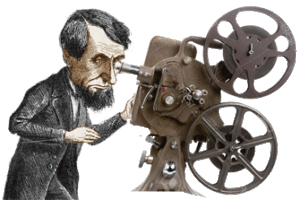 Technically, Lincoln didn’t attend the exhibition, but on this date, October 14, 1861, a committee of commissioners for the industrial exhibition in England visits President Lincoln in the White House and asks use of a government vessel to transport American contributions to the fair. Lincoln had supported United States participation.
Technically, Lincoln didn’t attend the exhibition, but on this date, October 14, 1861, a committee of commissioners for the industrial exhibition in England visits President Lincoln in the White House and asks use of a government vessel to transport American contributions to the fair. Lincoln had supported United States participation.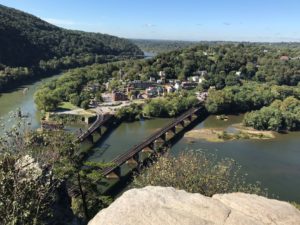 President Lincoln took a special train to Harpers Ferry on October 1, 1862. I drove my car to the National Park Service visitors center on October 1, 2021. Lincoln reviewed the troops on Bolivar Heights. I climbed to the overlook on Maryland Heights. One hundred and fifty-nine years separated us, but I still felt his presence.
President Lincoln took a special train to Harpers Ferry on October 1, 1862. I drove my car to the National Park Service visitors center on October 1, 2021. Lincoln reviewed the troops on Bolivar Heights. I climbed to the overlook on Maryland Heights. One hundred and fifty-nine years separated us, but I still felt his presence.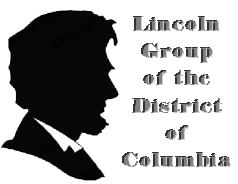 Back in mid-July, I was happy to report that the Lincoln Group of DC was going back to live, in-person, programming. What a difference a couple of months makes. As readers will already have seen, our October meeting with Ron White, originally planned as a big in-person luncheon shindig complete with special surprises, is not going to happen. Ron has rightfully reconsidered his travel to the east coast because of the pandemic. Instead, Ron will give us a virtual presentation on
Back in mid-July, I was happy to report that the Lincoln Group of DC was going back to live, in-person, programming. What a difference a couple of months makes. As readers will already have seen, our October meeting with Ron White, originally planned as a big in-person luncheon shindig complete with special surprises, is not going to happen. Ron has rightfully reconsidered his travel to the east coast because of the pandemic. Instead, Ron will give us a virtual presentation on 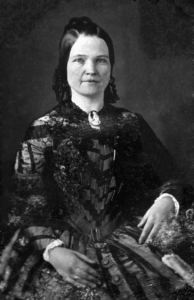 On this auspicious date in 1844, Mrs. Lincoln bought material to make corsets. Six yards of “gimp,” which was a strong twisted silk, wool, or cotton (not to be confused with the plastic form of gimp I used in Boy Scouts), along with ample amounts of lace. Presumably she already had whalebone or simply used over-starched fabric for stiffness. As critical as this was for containing the spreading remnants of Robert’s birth the previous year, this was only one of many important events happening on
On this auspicious date in 1844, Mrs. Lincoln bought material to make corsets. Six yards of “gimp,” which was a strong twisted silk, wool, or cotton (not to be confused with the plastic form of gimp I used in Boy Scouts), along with ample amounts of lace. Presumably she already had whalebone or simply used over-starched fabric for stiffness. As critical as this was for containing the spreading remnants of Robert’s birth the previous year, this was only one of many important events happening on 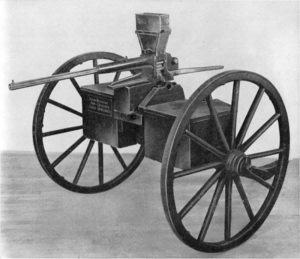 On August 17, 1861, Abraham Lincoln witnessed an exhibition of what Lincoln dubbed the “coffee mill gun.” Lincoln was always pushing for modernized weaponry beyond the standard muskets, which were inaccurate and slow to reload. He pushed Ordinance Chief James Ripley to put into service various breechloaders, rifles, carbines, and repeaters.
On August 17, 1861, Abraham Lincoln witnessed an exhibition of what Lincoln dubbed the “coffee mill gun.” Lincoln was always pushing for modernized weaponry beyond the standard muskets, which were inaccurate and slow to reload. He pushed Ordinance Chief James Ripley to put into service various breechloaders, rifles, carbines, and repeaters.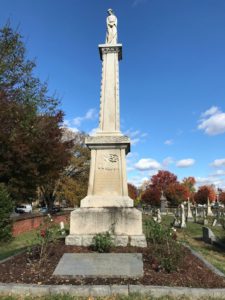 On July 27, 1864, Abraham Lincoln called on Edwin Stanton to increase the pay of women working in the cause of the Civil War. He wrote:
On July 27, 1864, Abraham Lincoln called on Edwin Stanton to increase the pay of women working in the cause of the Civil War. He wrote: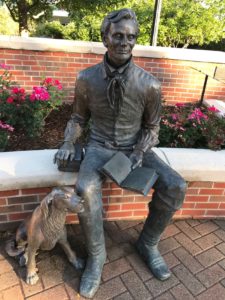 Famously, Abraham Lincoln wrote that he the “aggregate of all his schooling did not amount to one year.” He added that he “was never in a college or Academy as a student; and never inside of a college or academy building til since he had a law-license.” And yet, Lincoln is a college guy, of sorts.
Famously, Abraham Lincoln wrote that he the “aggregate of all his schooling did not amount to one year.” He added that he “was never in a college or Academy as a student; and never inside of a college or academy building til since he had a law-license.” And yet, Lincoln is a college guy, of sorts.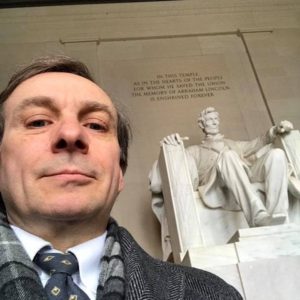 I often check
I often check 






